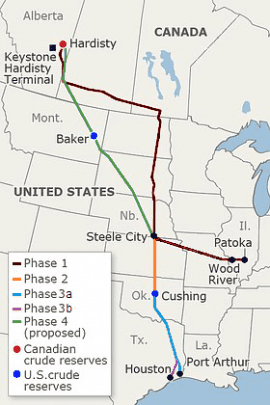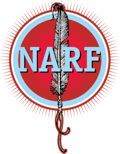President William Kindle of the Rosebud Sioux Tribe (Sicangu Lakota Oyate) promised continued vigilance in light of the Nebraska Public Service Commission’s decision today to permit TransCanada Corp.’s proposed Keystone XL pipeline to cross that state’s lands. The Rosebud Sioux Tribe has retained the Native American Rights Fund (NARF) to represent its interests with regard to the Keystone XL pipeline.
The pipeline’s proposed route crosses through traditional Lakota homelands and treaty territories, and will affect not only the Rosebud Sioux Tribe, but also Native Nations in Montana, South Dakota, and Nebraska. It also endangers the Ogallala Aquifer, which supplies water for Native and non-Native users’ residential and agricultural needs on the High Plains in eight states.
“The land, water, tribal sovereignty, and governmental services were not ‘given’ to us in those treaties,” President Kindle said. “They were bargained for with the blood of our ancestors. We will not dishonor our relatives and unnecessarily endanger our health, safety, and wellbeing. The Rosebud Sioux Tribe will take any and all necessary steps, up to and including litigation, to protect our people, our land and water, and our cultural and historic resources.”
“As we have seen, spills from such projects can be catastrophic,” said NARF Staff Attorney Matt Campbell. “The Rosebud Sioux Tribe—just like South Dakota, Nebraska, and Montana—has a duty to protect the health and welfare of its citizens. NARF will help the Tribe make sure it has considered all of its options for ensuring the safety of the Tribe’s citizens, territory, and resources.”
“This is their land, their water,” said NARF Staff Attorney Natalie Landreth. “They have laws protecting their water and those laws must be respected. Keystone XL will need permission from the Rosebud Sioux Tribe, so this is not over.”
See the open letter from President Kindle for more information on the Rosebud Sioux Tribe’s position.
A History of the Keystone Pipeline

The Keystone XL (KXL) Pipeline is the proposed Phase 4 of the Keystone Pipeline system, which already is online with a capacity to carry more than 500,000 barrels per day. The XL stands for “export limited.” If completed, the Keystone XL would add another 510,000 barrels of capacity.
Phase 1 of the Keystone Pipeline was permitted in March 2008. Phase 2 and 3 did not require Presidential Permits and were built over several years starting in 2010. Because it crosses the U.S.-Canada border, Phase 4 does require a Presidential Permit; however, it has been met with opposition since its initial proposal. A timeline of the Keystone Pipeline project is below.
2005
February: TransCanada Corporation proposes the Keystone Pipeline project.
2007
September: Canada’s National Energy Board approves the Canadian section.
2008
January: ConocoPhillips acquires a 50% stake in the project.
March: The U.S. Department of State issues a Presidential Permit authorizing Keystone facilities at the U.S.-Canada border.
September: TransCanada and ConocoPhillips file an application for the Keystone XL Phase 4 extension.
2009
Pipeline representatives start visiting landowners potentially affected by Keystone XL. Opposition emerges in Nebraska.
June: TransCanada announces it will buy ConocoPhillips’ stake in Keystone.
2010
March: Canada’s National Energy Board approves the Canadian section of the Keystone XL.
June: Phase 1 of the Keystone Pipeline goes online. It runs from Hardisty, Alberta, to Patoka, Illinois.
June-July: Increased opposition to Keystone XL includes legislators and scientists speaking out against the project; the Environmental Protection Agency questions the need for the pipeline extension.
July: The State Department extends its review of Keystone, saying they need more time for review before a final environmental impact assessment can be released.
2011
February : The Keystone-Cushing Phase 2 of the pipeline goes online. It connects Steele City, Nebraska, to Cushing, Oklahoma.
August: The State Department releases its final environmental assessment that the pipeline would have a limited environmental impact.
August-September: Keystone XL protesters organize two weeks of civil disobedience at the White House. Police arrest approximately one thousand people.
December: U.S. legislators pass a bill with a provision saying President Barack Obama must make a decision on the pipeline’s future in the next 60 days.
2012
January: Obama rejects the Keystone Pipeline, saying the December bill did not allow enough time to review the new route. Obama says TransCanada is free to submit another application.
February: TransCanada announces it will build Phase 3 of the Keystone Pipeline as a separate project that is not subject to presidential permission, since it does not cross an international border.
April: TransCanada submits a new route to officials in Nebraska for approval.
May: TransCanada files a new application with the State Department for the northern part of Keystone XL.
2013
January: Nebraska Gov. Dave Heineman approves the proposed route for Keystone XL, sending the project back to the State Department for review. Pipeline opponents file a lawsuit against the Nebraska government claiming the state law used to review the new route is unconstitutional.
2014
January: The Cushing MarketLink Phase 3a pipeline goes online. It connects Cushing, Oklahoma, to Port Arthur, Texas. Phase 3b is added later, connecting the pipeline from Port Arthur to Houston, Texas.
February: A Nebraska judge rules that the law that allowed the governor to approve Keystone XL over the objections of landowners was unconstitutional. Nebraska appeals.
April: The State Department suspends the regulatory process indefinitely, citing uncertainty about the court case in Nebraska.
November: TransCanada says the costs of Keystone XL have grown to US$8 billion from US$5.4 billion. Elections turn control of the U.S. Congress over to Republicans, who pledge to move forward on Keystone XL.
2015
January: The Nebraska Supreme Court narrowly strikes down the lower-court decision, ruling that the governor’s actions were constitutional. The U.S. Senate approves a bill to build Keystone XL.
February: Obama vetoes the bill.
November: The Obama administration rejects TransCanada’s application to build the Keystone XL pipeline.
2016
November: Trump elected president.
2017
January: Trump signs a presidential memorandum inviting TransCanada to resubmit their application for a Presidential Permit and directing the Secretary of State, Department of the Interior, and Department of the Army to fast-track the decision. He also signs an order requiring pipelines in the United States to be built with U.S. steel.
March: The Trump White House exempts the Keystone Pipeline from the requirement to use U.S. steel.
Read the latest on the Keystone XL Pipeline case.
More blog posts

